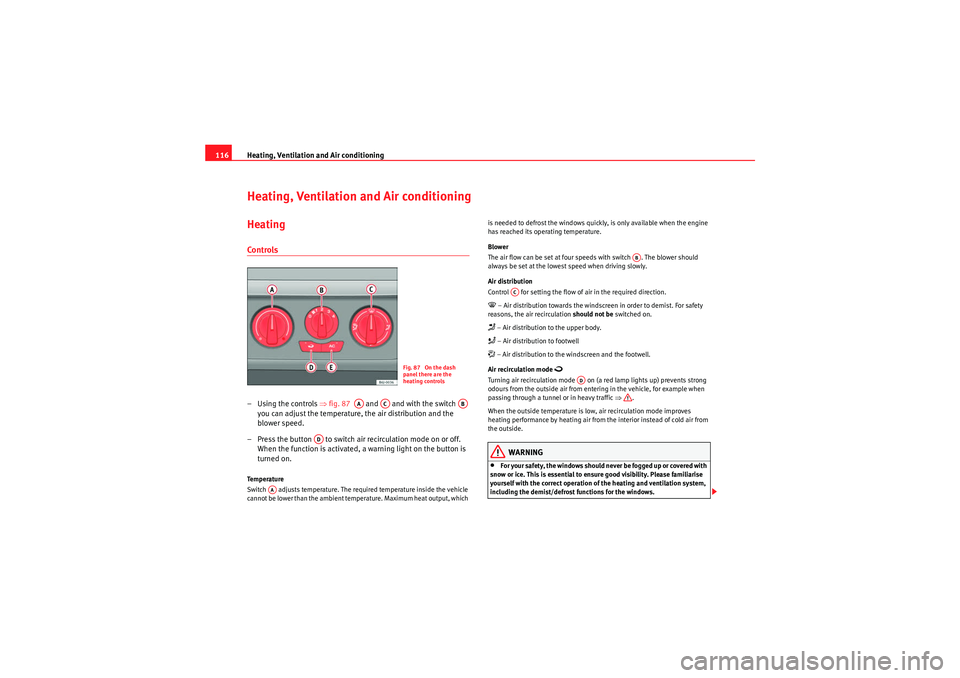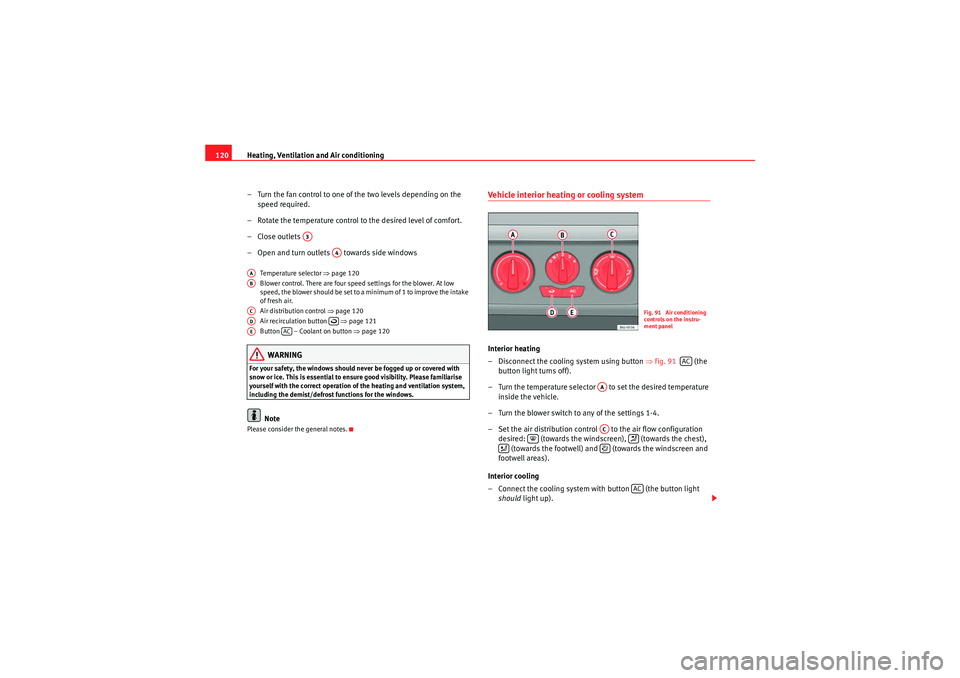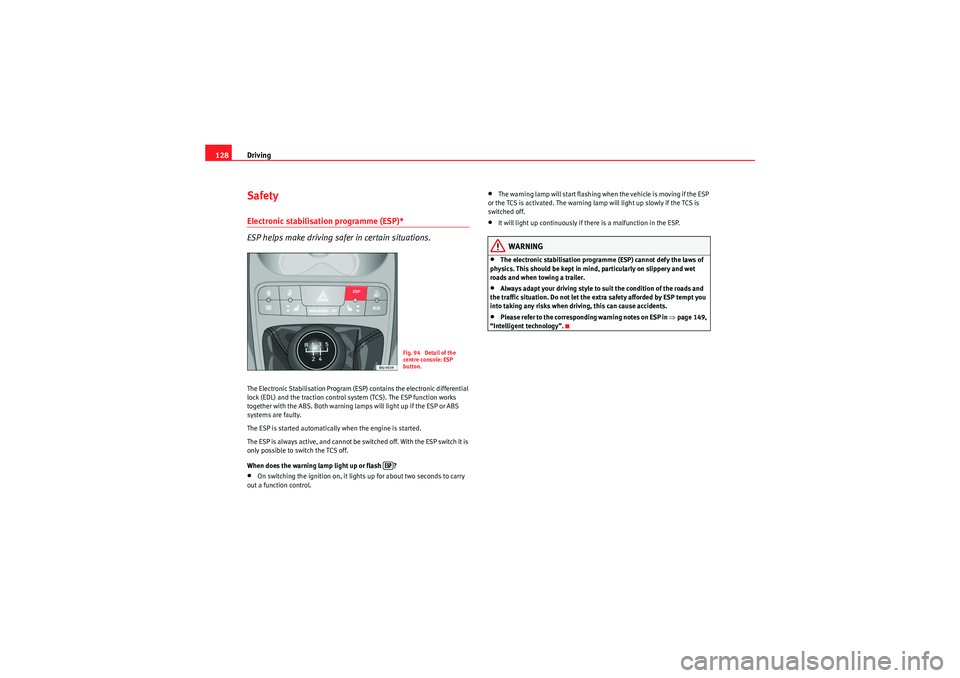2009 Seat Ibiza 5D light
[x] Cancel search: lightPage 118 of 257

Heating, Ventilation and Air conditioning
116Heating, Ventilation and Air conditioningHeatingControls– Using the controls ⇒fig. 87 and and with the switch
you can adjust the temperature, the air distribution and the
blower speed.
– Press the button to switch air recirculation mode on or off. When the function is activated, a warning light on the button is
turned on.Te m p e r a t u r e
Switch adjusts temperature. The required temperature inside the vehicle
cannot be lower than the ambient temperature. Maximum heat output, which is needed to defrost the windows quickly, is only available when the engine
has reached its operating temperature.
Blower
The air flow can be set at four speeds with switch . The blower should
always be set at the lowest speed when driving slowly.
Air distribution
Control for setting the flow of air in the required direction.
– Air distribution towards the windscreen in order to demist. For safety
reasons, the air recirculation should not be switched on. – Air distribution to the upper body. – Air distribution to footwell – Air distribution to the windscreen and the footwell.
Air recirculation mode
Turning air recirculation mode on (a red lamp lights up) prevents strong
odours from the outside air from entering in the vehicle, for example when
passing through a tunnel or in heavy traffic ⇒.
When the outside temperature is low, air recirculation mode improves
heating performance by heating air from the interior instead of cold air from
the outside.
WARNING
•For your safety, the windows should never be fogged up or covered with
snow or ice. This is essential to ensure good visibility. Please familiarise
yourself with the correct operation of the heating and ventilation system,
including the demist/defrost functions for the windows.
Fig. 87 On the dash
panel there are the
heating controls
AA
AC
AB
AD
AA
AB
AC
AD
Ibiza_EN.book Seite 116 Montag, 14. September 2009 6:19 18
Page 121 of 257

Heating, Ventilation and Air conditioning119
Safety First
Controls and equipment
Practical tips
Technical Data
Air distribution
Outlets and can be closed or opened separately and the air flow
directed according to needs.
Air conditioning* ControlsThe air conditioning system only works when the engine is running
and the fan is switched on.
–Using the controls
⇒fig. 90 and and with the switch
you can adjust the temperature, the air distribution and the
blower speed.
– To switch a function on or off, press the appropriate button or . When the function is activated, a red warning light on the
button is turned on.
– To demist the wind screens:
– Turn air distribution to
Switch on symbol
Main air output through outlets:
1, 2
5
1, 2, 5
3, 4
AC
A3
A4
Fig. 90 Air conditioning
controls on the instru-
ment panel
AA
AC
ABAD
AE
Ibiza_EN.book Seite 119 Montag, 14. September 2009 6:19 18
Page 122 of 257

Heating, Ventilation and Air conditioning
120
– Turn the fan control to one of the two levels depending on the speed required.
– Rotate the temperature control to the desired level of comfort.
–Close outlets
– Open and turn outlets towards side windows
Temperature selector ⇒page 120
Blower control. There are four speed settings for the blower. At low
speed, the blower should be set to a minimum of 1 to improve the intake
of fresh air.
Air distribution control ⇒page 120
Air recirculation button ⇒page 121
Button – Coolant on button ⇒page 120WARNING
For your safety, the windows should never be fogged up or covered with
snow or ice. This is essential to ensure good visibility. Please familiarise
yourself with the correct operation of the heating and ventilation system,
including the demist/defrost functions for the windows.
Note
Please consider the general notes.
Vehicle interior heating or cooling system Interior heating
– Disconnect the cooling system using button ⇒fig. 91 (the
button light turns off).
– Turn the temperature selector to set the desired temperature inside the vehicle.
– Turn the blower switch to any of the settings 1-4.
– Set the air distribution control to the air flow configuration desired: (towards the windscreen), (towards the chest), (towards the footwell) and (towards the windscreen and
footwell areas).
Interior cooling
– Connect the cooling system with button (the button light should light up).
A3
A4
AAABACAD
AE
AC
Fig. 91 Air conditioning
controls on the instru-
ment panel
AC
AAAC
AC
Ibiza_EN.book Seite 120 Montag, 14. September 2009 6:19 18
Page 123 of 257

Heating, Ventilation and Air conditioning121
Safety First
Controls and equipment
Practical tips
Technical Data
– Turn the temperature control switch until the desired interior
temperature is reached.
– Turn the blower switch to any of the settings 1-4.
– Set the air distribution contro l to the air flow configuration
desired: (towards the windscreen), (towards the chest),
(towards the footwell) and (towards the windscreen and
footwell areas).Heating
Maximum heat output, which is needed to defrost the windows quickly, is
only available when the engine has reached its operating temperature.
Coolant system
When the air conditioning is switched on, the temperature and the air
humidity go down. This way, if the outside humidity is extreme, the air condi-
tioning prevents the misting of the windows and therefore, comfort is
improved.
If the air conditioning does not work, this may be due to the following
reasons:•The engine is stationary.•The fan blower is switched off.•The outside temperature is below +3°C.•The cooling system compressor has been temporarily switched off
because of an increased engine coolant temperature.•The air conditioning fuse is faulty.•Another fault in the vehicle. Have the air conditioning checked by a qual-
ified workshop.
Air recirculation
Air recirculation mode prevents fumes or unpleasant smells
from coming from the outside.When air recirculation mode is switched on (button ⇒ page 120, fig. 91
with warning lamp) strong odours in the outside air do not enter the vehicle
interior, for example when passing through a tunnel or in a traffic jam.
When the outside temperature is low, air recirculation mode improves
heating performance by heating air from the interior instead of cold air from
the outside.
When the outside temperature is high, air recirculation mode improves
cooling performance by cooling air from the interior instead of warm air from
outside.
For safety reasons, the air recirculation should not be switched on when the
air distribution control is being adjusted to the windscreen setting
.
WARNING
In air recirculation mode, no cold air from the outside enters the vehicle
interior. If the air conditioning system is switched off, the windows can
quickly mist over. Therefore, never leave the air recirculation mode
switched on for a long time (risk of accident).
Note
•When engaging reverse gear, the air recirculation is connected automati-
cally to prevent the entrance of exhaust fumes in the vehicle on travelling
backwards. The control light on the button does not light up.•If the temperature control is turned to the coldest setting (blue point) and
the switch is activated, the “Air recirculation” function is automatically
activated in order to cool the vehicle rapidly using less energy; its function
indicator will light.
AC
Ibiza_EN.book Seite 121 Montag, 14. September 2009 6:19 18
Page 126 of 257

Heating, Ventilation and Air conditioning
124imate temperatures which may slightly vary depending on the outside condi-
tions.
Climatronic maintains a constant temperature. To do it, it automatically regu-
lates the supplied air temperature, the blower speed and the air distribution.
The system also considers the sunlight radiation, so there is no need for
manual readjustment. Therefore, automatic mode almost always provides
the best comfort for the vehicle occupants throughout the year.
Automatic mode is switched off whenever an adjustment is made using the
buttons for the air distribution, blower or . The temperature continues to
self-regulate.Manual mode
In manual mode the air temperature, flow, and the desired air
distribution can be adjusted.Switching on manual mode
– Press one of the buttons ⇒ page 122, fig. 92 to or press
the blower control and down. The indicator is switched
off.Te m p e r a t u r e
The passenger compartment temperature can be set between +18°C (64°F)
and +29°C (86°F). These are approximate temperatures which may slightly
vary depending on the outside conditions.
If a temperature below 18°C (64°F) is selected, the display switches to LO In
this setting the system runs at maximum cooling output and the temperature
is not regulated. If a temperature above 29°C (86°F) is selected, the display switches to
HI In
this setting the system runs at maximum heating output and the temperature
is not controlled.
Blower
The blower can be adjusted with buttons and ⇒page 122, fig. 92 . If
the blower is off (level is not shown on the screen) and button is kept
pressed down, the Climatronic switches off. Then OFF is displayed on the
screen.
Air distribution
The air distribution is adjusted using the buttons , and . It is also
possible to open and close some of the air outlets separately.
Switching the air conditioning system on and off
By pressing the button, the air cooling system can be switched off in
order to save fuel. The temperature continues to self-regulate. The set
temperature can then only be reached if it is higher than the outside
temperature.
Air recirculation mode
Air recirculation mode prevents fumes or unpleasant smells
from coming from the outside.– Press the button to switch air recirculation mode on or off. This is ON if the symbol
⇒ page 122, fig. 92 is displayed on
the screen.
Air recirculation mode prevents strong odours in the ambient air from
entering the vehicle interior, for example when passing through a tunnel or in
a traffic jam.
AC
A14
A16
A8
A9
A3
A8
A9
A1
A9
AC
Ibiza_EN.book Seite 124 Montag, 14. September 2009 6:19 18
Page 130 of 257

Driving
128SafetyElectronic stabilisation programme (ESP)*
ESP helps make driving safer in certain situations.The Electronic Stabilisation Program (ESP) contains the electronic differential
lock (EDL) and the traction control system (TCS). The ESP function works
together with the ABS. Both warning lamps will light up if the ESP or ABS
systems are faulty.
The ESP is started automatically when the engine is started.
The ESP is always active, and cannot be switched off. With the ESP switch it is
only possible to switch the TCS off.
When does the warning lamp light up or flash ?•On switching the ignition on, it lights up for about two seconds to carry
out a function control.
•The warning lamp will start flashing when the vehicle is moving if the ESP
or the TCS is activated. The warning lamp will light up slowly if the TCS is
switched off.•It will light up continuously if there is a malfunction in the ESP.WARNING
•The electronic stabilisation programme (ESP) cannot defy the laws of
physics. This should be kept in mi nd, particularly on slippery and wet
roads and when towing a trailer.•Always adapt your driving style to suit the condition of the roads and
the traffic situation. Do not let the extra safety afforded by ESP tempt you
into taking any risks when driving, this can cause accidents.•Please refer to the corresponding warning notes on ESP in ⇒page 149,
“Intelligent technology”.
Fig. 94 Detail of the
centre console: ESP
button.
Ibiza_EN.book Seite 128 Montag, 14. September 2009 6:19 18
Page 132 of 257

Driving
130The immobiliser will be activated again automatically as soon as you pull the
key out of the ignition lock.
The engine can only be started using a genuine SEAT key with its correct code.
Note
A perfect operation of the vehicle is ensured if genuine SEAT keys are used.Starting and stopping the engineStarting petrol engines
The engine can only be started using a genuine SEAT key with
its correct code.– Move the gear lever to the neutral position and depress the
clutch pedal thoroughly and hold it in this position for the starter
to turn the engine on.
– Turn the ignition key to the starting position ⇒page 129.
– Le t go o f t he ign itio n key as so o n as t he eng in e sta r ts; t he sta r te r motor must not run on with the engine.After starting a very hot engine, you may need to slightly press down the
accelerator.
When starting a very cold engine, it may be a little noisy for the first few
seconds until oil pressure has built up in the hydraulic valve compensators.
This is quite normal, and no cause for concern. If the engine does not start immediately, switch the starter off after
10 seconds and try again after half a minute. If the engine still does not start,
please check the fuel pump fuse
⇒page 207, “Fuses”.
WARNING
•Never start or run the engine in un ventilated or closed rooms. The
exhaust fumes contain carbon monoxide, an odourless and colourless
poisonous gas. Risk of fatal accidents. Carbon monoxide can cause loss of
consciousness. It can also cause death.•Never leave the vehicle unattended if the engine is running.•Never use “cold start sprays”, they could explode or cause the engine
to run at high revs. Risk of injury.Caution
•When the engine is cold, you should avoid high engine speeds, driving at
full throttle and over-loading the engine. Risk of engine damage.•The vehicle should not be pushed or towed more than 50 metres to start
the engine. Unburnt fuel could enter the catalytic converter and damage it.•Before attempting to push-start or tow a vehicle in order to start it, you
should first try to start it using the battery of another vehicle. Note and follow
the instructions in ⇒ page 219, “Jump-starting”.For the sake of the environment
Do not warm-up the engine by running the engine with the vehicle stationary.
You should drive off as soon as you start the engine. This helps the engine
reach operating temperature faster and reduces emissions.
Ibiza_EN.book Seite 130 Montag, 14. September 2009 6:19 18
Page 133 of 257

Driving131
Safety First
Controls and equipment
Practical tips
Technical Data
Starting diesel engines
The engine can only be started using a genuine SEAT key with
its correct code.– Move the gear lever to the neutral position and depress the
clutch pedal thoroughly and hold it in this position for the starter
to turn the engine on.
– Turn the ignition key to the starting position.
– Turn the ignition key to position ⇒page 129, fig. 95 . The
indication lamp
will light for engine pre-heating.
– When the warning lamp turns off, turn the key to position to start the engine. Do not press the accelerator.
– Let go of the ignition key as soon as the engine starts, the starter motor must not be allowed to run on with the engine.
When starting a very cold engine, it may be a little noisy for the first few
seconds until oil pressure has built up in the hydraulic valve compensators.
This is quite normal, and no cause for concern.
If there are problems with starting the engine, see ⇒ page 219.
Glow plug system for the diesel engine
To avoid unnecessary discharging of the battery, do not use any other major
electrical equipment while the glow plugs are pre-heating.
Start the engine as soon as the glow plug warning lamp goes out.
Starting the engine after the fuel tank has been completely run dry
If the fuel tank has been completely run dry, it may take longer than normal
(up to one minute) to start the engine after refuelling with diesel fuel. This is
because the system must eliminate air first.
WARNING
•Never start or run the engine in unventilated or closed rooms. The
exhaust fumes contain carbon monoxide, an odourless and colourless
poisonous gas. Risk of fatal accidents. Carbon monoxide can cause loss of
consciousness. It can also cause death.•Never leave the vehicle unattended if the engine is running.•Never use “cold start sprays”, they could explode or cause the engine
to run at high revs. Risk of injury.Caution
•When the engine is cold, you should avoid high engine speeds, driving at
full throttle and over-loading the engine. Risk of engine damage.•The vehicle should not be pushed or towed more than 50 metres to start
the engine. Unburnt fuel could enter the catalytic converter and damage it.•Before attempting to push-start or tow a vehicle in order to start it, you
should first try to start it using the battery of another vehicle. Note and follow
the instructions in ⇒page 219, “Jump-starting”.For the sake of the environment
Do not warm-up the engine by running the engine with the vehicle stationary.
You should drive off as soon as you start the engine. This helps the engine
reach operating temperature faster and reduces emissions.Switching the engine off– Stop the engine.
– Turn the ignition key to position ⇒page 129, fig. 95 .
A2A3
A1
Ibiza_EN.book Seite 131 Montag, 14. September 2009 6:19 18